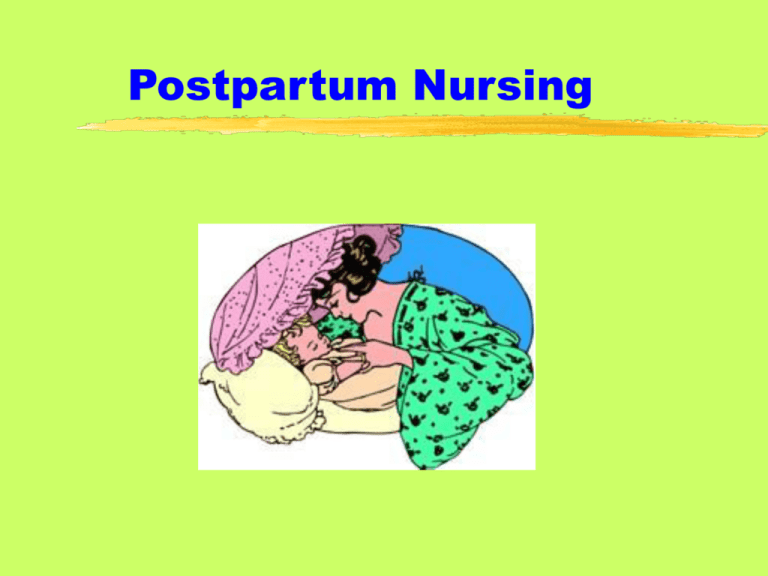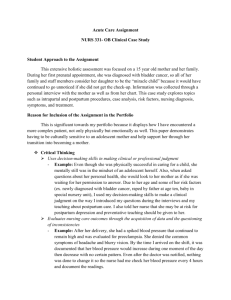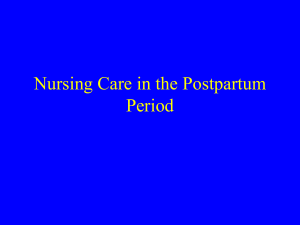Postpartum Nursing
advertisement

Postpartum Nursing Postpartum or Puerperium Period of 6 wks after delivery during which the reproductive system and the body returns to normal immediate--first 24 hrs early--first week late--2nd to 6th week Dramatic Changes in every body system While Changes are normal, in no other period of life is there such marked and rapid catabolism Wt. Loss ot 15-17 lbs. Possibly more if breastfeeding. Changes in the following: Uterus Breasts Perineum Vagina Elimination urinary bowels Endocrine Reproductive Cardiovascular Blood Changes Vital Signs Abd. musculature Sleeping and rest Psychological Uterine Involution Blood vessels contract, uterus shrinks Involutes at 1cm/day 1cm=1fingerbreadth Below the symphysis by 10-12 days Process for involution=autolysis of protein 1000gm at delivery, 60gm at 6 wks pp Autolysis Outer decidua and autolysed protein excreted in lochia Inner decidua forms new endometrium Entire endometrium restored in 3 wk, except for placental site Large bld vess. degenerate, replaced by smaller ones. Cervix never returns to nulliparous state Nursing care r/t uterine changes Palpate fundus at frequent intervals q. q. q. q. 15” X 1hr 1hr X 2 2hr X 2 4 hrs up to 24-48 hrs. post delivery Massage if not firm Deviation and above umb. may signal full bladder Lochia Vaginal discharge after delivery,composed of leukocytes, epithelial cells, decidua, autolysed protein and bacteria. Rubra--delivery to 3rd day Serosa--days 4-10 Alba--10--several weeks post delivery Assess color, amt, odor, clots Cramping or “Afterpains” Primigravida--uterus tonically contracted unless clots or tissue remain in uterus. Multipara--uterus contracts and relaxes at intervals causing “afterpains”. More severe when breasfeeding in both primiparas and multiparas. Breast Changes Colostrum secreted from third tri. until lactation begins Milk--lactation 3rd pp day Engorgement from increased vascular and lymphatic circulation Decreased/absent placental hormones cause prolactin to be secreted=lactation Check breasts for engorgement, nipple cracks, soreness Suppression of Lactation Avoid breast stimulation Ice Tight bra Do not pump or express milk Homonal suppression (rarely) Perineal Changes Episiotomy--subcuticular sutures Pain for 24-48 hrs ice for 24 hrs then heat (sitz baths) Analgesics, systemic and topical Sit properly Keep clean--perineal care Evaluate Episiotomy or Perineal lac. for REEDA Redness Edema Ecchymosis Drainage Approximation Vaginal Changes rugae absent--return in 3 wks edematous--venous congestion for 3 days distention--decreases but never back to nulliparous state lacerations hymenal tags labia flabby, improve but never back to nulliparous state Urinary Elimination Bladder Changes edema and hyperemia,extravasation increased capacity, decreased sensitivity overdistension with incomplete emptying urethral trauma may cause dysuria Note, transient glycosuria, proteinuria, and keytonuria are normal in immediate pp. period. Problems with urinary elimination Dysuria IV fluids cause bladder fullness regional anesthesia and decreased abdominal pressure=pt unaware of full bladder Nursing Care Check bladder frequently post delivery Full bladder can inhibit uterine contraction=bleeding Signs of full postpartum bladder=uterus high and displaced to side (usually R) If no void in 4-6hrs, catheterize Check amount of voiding (retention with overflow possible) Retention with overflow When bladder is overdistended pt. will void small amouts without emptying bladder. If catheterize for an overdistended bladder, remove only 1000cc and then clamp and consult MD If unable to void after cathX2, Foley indicated Bowel Elimination Constipation r/t decreased peristalisis decreased intra abdominal pressure hemorrhoidal discomfort perineal discomfort Increase roughage and fluids, laxatives and suppositories--bowels normal by 1wk pp Endocrine Changes Placental estrogen and progesterone removed Prolactin increases, esp in breastfeeding women Estrogen begins to increase to follicular levels at 3-4 wks p. Delivery Menstruation returns--6 wks not breastfeeding, 2-18 mos breastfeeding Cardiovascular Changes Blood volume goes rapidly from hypervolemia to hypovolemia blood loss 400-500cc vaginal delivery 700-1000 cc Csection Blood Components HCT (down 4pts for each pt blood lost) Leucocytes(15,000 to 30,000 mm3) Lymphocytes Fibrinogen--risk of thrombophlebitis ESR Vital Signs BP first then increases during uterine massage/pain if PIH may stay elevated orthostatic hypotension common Temp first then P-- R-- Other changes Postpartum Chill Shaking chill due to vasomotor instability Postpartum diaphoresis night sweats and increased odor Abdominal Musculature muscle tone--soft, weak, flabby diastasis recti remains May do head and shoulder raises and lie on abdomen--ask MD about resumption of more vigourous activity (other muscles may be weak due to the exertion of delivery and lactic acidosis) Sleep and Rest Patterns Sleep and rest patterns disrupted during thrird trimester and continue to be disrupted during pp period excitement anxiety discomfort baby feedings Psychological Changes The new mother must move from dependent to independent in a short time Reva Rubins three stages of the postpartum Taking in Taking hold Letting go (taking over) Taking in phase Focused on self (not infant) dependent on others for help in care needs assistance decision making difficult comfort-rest-food needs paramount relives delivery experience May last for several hours or days Taking hold phase Moving from dependence to independence energy level focus on infant self care, focus on bowels, bladder, brfeed responds to instruction, praise Lasts from 2days to 1wk Letting go phase Giving up previous role See self as separate from infant Give up fantasy delivery and baby Readjustment Depression and grief work from 1wk Postpartum blues Reduction of progesterone, delayed prolactin release and changes in other placental hormones may trigger emotional instability Body image changes and dependency needs may contribute Overconcern re infant and self, and emotional lability are “normal” during the first 5-10 days after delivery Postpartum depression Rejection of infant, or fears that she may harm infant call for immediate intervention. Remind mom during postpartum teaching that these feelings sometimes occur and help is available







![Title: [S4- poster] A longitudinal study of postpartum depression](http://s3.studylib.net/store/data/008396555_1-6c02377a087cf9a182a8798d6fbda024-300x300.png)

